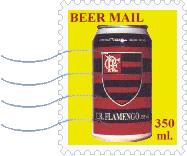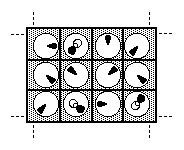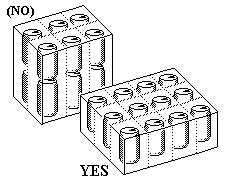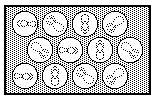Safe Boxes In Trading By Mail
 |
Safe Boxes
For Trading By Mail
(revised: 25 October 1998) |
 |
Most collectors have their own method of packing cans, there's no standard way for doing this.
But any collector having experienced how disappointing it is to receive a long-waited parcel
only to discover that many of the cans have been well smashed up during a rough journey, knows
the importance of a safe parcel when shipping cans by mail.
MAILING EMPTY CANS
Empty cans are rather light, and less expensive to send.
There's a big difference between older "steels" and more recent aluminium and "extruded"
cans, as the latter may weigh up to 10 times less, but they are also far less resistant: especially
these ones are very likely to receive bad dents (or might even be totally crushed) if the
parcel is mishandled.
The most vulnerable part of a can is on its sides, while it is quite resistant to
big weights applied from the top or from the bottom (i.e. a can will bear the weight of a man
standing on top of it, but it will get dented by simply pressing it with two fingers on its body).
Therefore, special attention must be given to prevent blows coming from the sides of the
parcel, even though also strong vertical blows may leave on the neck or the bottom of the can nasty marks.
As it is impossible to prevent the parcel from being mishandled, these few hints will
considerably reduce the risk of damage:
- Use a strong box! Cardboard ones are the most common because easily obtainable; anyway,
be sure that the box is still in good condition (i.e. it should not be worn out or weakened
from previous use). If the cardboard is too thin or damaged, all the following points will be
useless!
- Use 'separators' (as in picture), eventually making them yourself using spare pieces of
cardboard from another box: they are very important, because they give strength to the sides
of the parcel in the middle part, where the box is much less resistant. They should fit more
or less exactly the width and the depth of the box (no need to fit exactly the height, instead).
The stronger the cardboard used for making them, the safer the protection they give.
|
 | |
Always insert the cans vertically: since parcels are often piled one on top of the other,
in vertical position the cans will offer their maximum resistance. For this same
reason it is better not to insert cans higher than the parcel itself (i.e. no hump should
be seen on the top of the box after closing it), as the tallest can of the group would
easily get damaged.
|
 |
Leave a little space between the cans and the sides of the box: it is very important
for the cans not to be too close to the cardboard, as they would easily be dented.
Leave a gap no less than 2 cm / 1 inch wide, which will later be filled with crimpled paper or
other packing material (not too tightly pressed!): this will keep the cans away from the box
sides, so that all blows from the outside should be absorbed by the separators.
Two more hints: |
 |
- A few Fragile, Handle with Care or similar notices added
to the parcel would probably bring a little further protection.
In some countries, though, the use of such notices might require a "fragile scheme" postage fee
(sometimes this is quite expensive): if you are not sure about this, ask your local post
office for information.
- It is not safe to pack cans in a double layer, unless the box is really
strong enough and separators are very tough: a tall box offers much less side resistance
than a low one. Therefore, in shipping a lot of cans, a wide box would give better
results than a tall one (or, eventually, the lot could be split into two separate
smaller parcels).
|
 |
MAILING FULL CANS
Their heavy weight makes them rather expensive to send by mail, but they travel safer than
empty cans because they are much more resistant.
Anyway, they should not bump into each other as they could scratch, or suffer minor
dents and marks, or even burst.
It is sufficient to wrap each of them with plastic "air-bubble" packing sheets,
and keep them safely into place with plenty of crimpled newspaper, polystirene chips, or
similar material, eventually using separators as for empty cans.
If separators are not used, cans may be arranged in alternate rows, as in picture, to save a
little space. |
 |
CUSTOMS DECLARATION FORM
An important thing to remember when shipping cans abroad, either empty or full, is to add
a declaration of the parcel's contents for the customs: the postal service of most countries
provides a small green form, similar to the one in the picture, which must be
filled in and stuck on the parcel by the sender.
Without this declaration, the box is very likely to be opened and checked by the
customs officers (which are not always careful in handling empty cans), often causing
also a further delay in receiving the parcel.
|
 |
 back to the Beercanopædia index · or ·
back to the Beer Index
back to the Beercanopædia index · or ·
back to the Beer Index